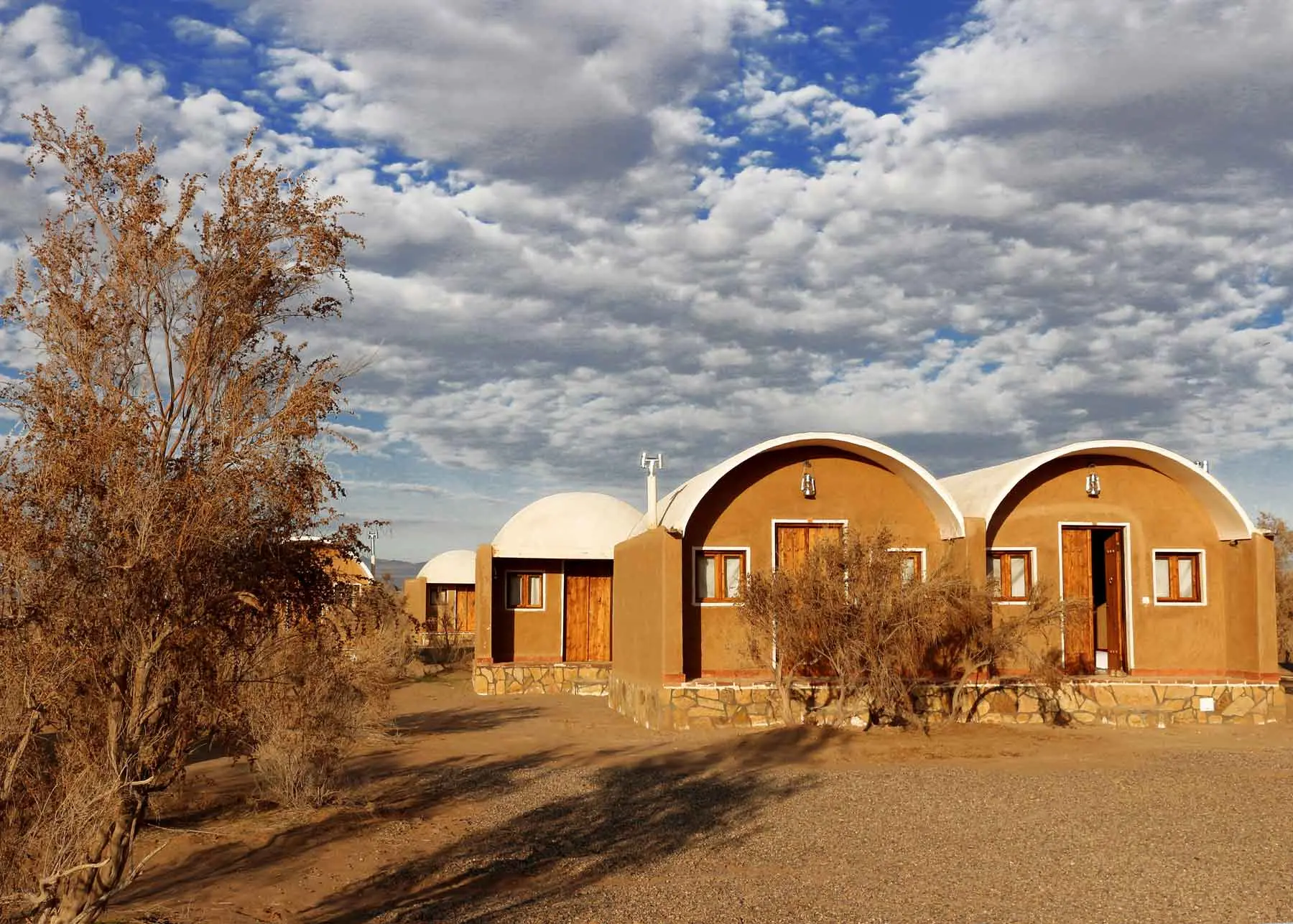Planning a Ziyarat pilgrimage to Iran? Iran is home to some of the most important and sacred shrines in the Islamic world. Whether you’re drawn to the spiritual atmosphere of the grand Imam Reza Shrine in Mashhad or the peaceful serenity of the Fatima Masumeh Shrine in Qom, Iran offers a deeply meaningful experience for every pilgrim. In this guide, you’ll discover the top Ziyarat destinations across the country, learn how to perform the pilgrimage rituals with respect and devotion, and find out how Visit Our Iran can help you with everything from visa support to travel arrangements for a smooth and fulfilling journey.
Imam Reza Holy Shrine in Mashhad
The Imam Reza Shrine in Mashhad is one of Iran’s most significant religious sites, attracting millions of visitors each year. This beautiful complex houses the tomb of Imam Reza, the eighth Shia Imam, and is a peaceful sanctuary for those seeking spiritual reflection. The shrine is known for its stunning architecture, including its golden dome and intricate tile work. The courtyards and halls are filled with mesmerizing mosaics and mirror work, offering a unique blend of art and spirituality that makes this site a must-see for anyone visiting Iran.
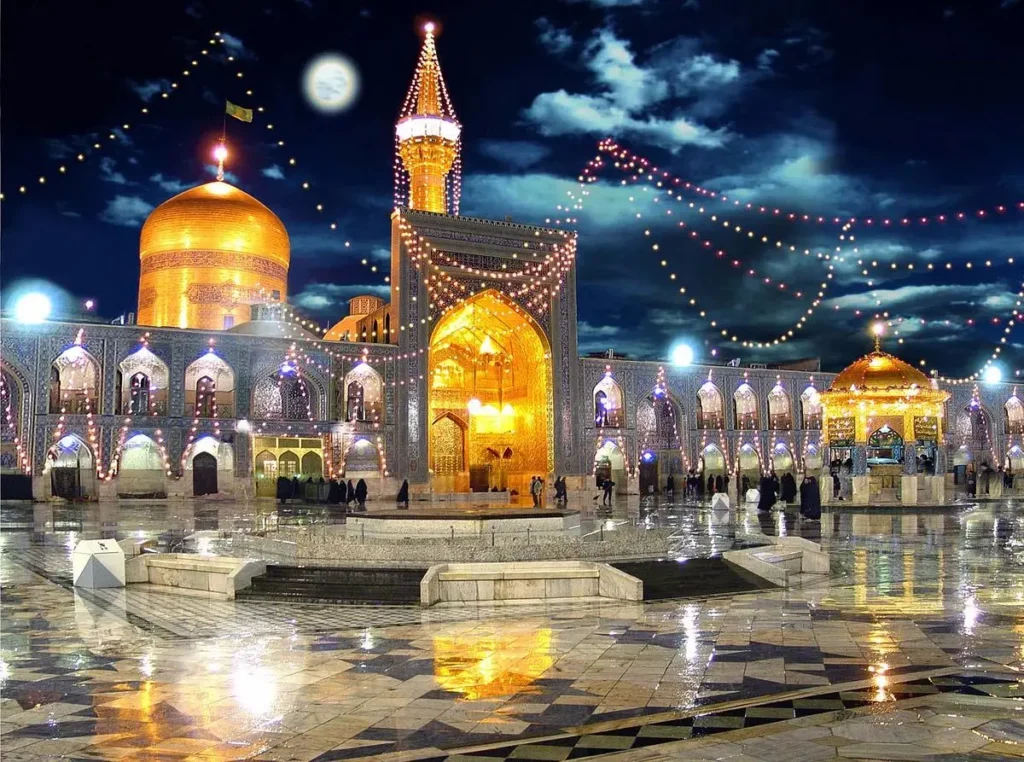
Visiting the shrine is free, and you can explore it at your own pace. While you’re there, don’t miss the Goharshad Mosque, renowned for its blue dome and detailed tile decorations. The shrine complex also includes museums and libraries, providing deeper insight into the region’s culture and history. You can spend a few hours admiring the architectural beauty or simply enjoy the peaceful atmosphere. For a truly serene experience, consider visiting during the quieter winter months, when the crowds are smaller.
Beyond the shrine, Mashhad has several attractions worth exploring. Nearby, you’ll find the Nadir Shah Afshar Tomb and the Vakilabad Forest Park, both offering a mix of history and nature. The local bazaars are a great place to pick up souvenirs, and you can also visit the Mashhad Museum to learn more about the city’s rich cultural heritage. All these sights, combined with the spiritual experience of the shrine, make Mashhad a city full of fascinating opportunities for exploration.
Visiting Mashhad? Discover the must-see attractions in Mashhad, from sacred shrines to cultural gems, this guide has it all.
Fatima Masumeh Shrine in Qom
When you visit Qom, one of the most important places you should explore is the Shrine of Fatima Masumeh, the sister of Imam Reza and daughter of Imam Musa al-Kazim. This shrine is the second most significant religious site in Iran and has been listed as a national heritage site since 1931. People from across Iran and other countries travel here every year for pilgrimage and reflection. Besides its religious importance, the shrine is also a historical landmark, with many parts dating back to the early Islamic centuries.
Fatima Masumeh passed away in Qom while traveling to meet her brother. She was welcomed by the people of Qom and buried in a garden donated by Musa ibn Khazraj, a respected figure of that time. Over the years, rulers from different dynasties, including the Seljuks, Safavids, and Qajars, expanded and decorated the site with domes, courtyards, and beautiful tile work.
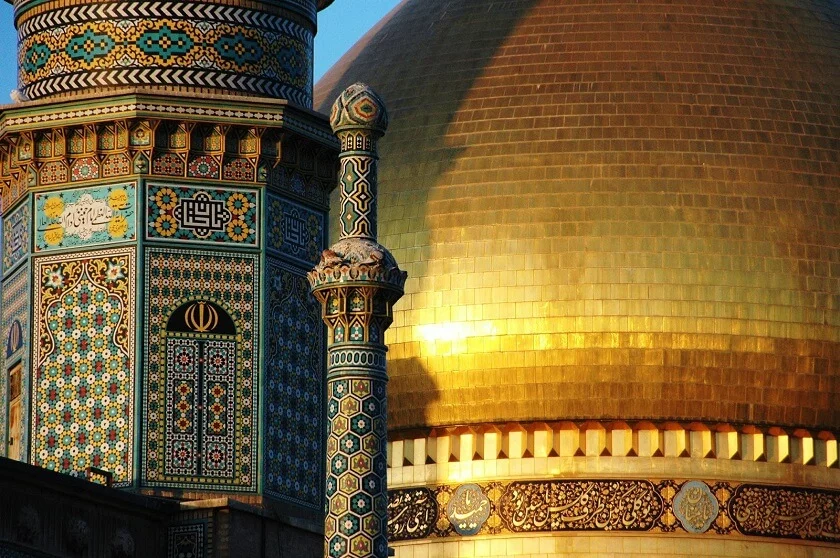
As you walk through the shrine complex, you’ll find a peaceful and majestic atmosphere filled with detailed architecture and spiritual meaning. The shrine includes several sections such as libraries, museums, prayer halls, and tomb chambers. You can see mirror work, tile decorations, and carved stones throughout the buildings. Notable figures such as members of the Safavid and Qajar royal families, as well as the famous poet Parvin E’tesami, are also buried here.
Many visitors also find it interesting that the special prayer for Fatima Masumeh was narrated by her brother, Imam Reza, which is rare for shrines. Inside the complex, you’ll find modern services such as electric transport for visitors, restrooms, a guesthouse, emergency services, gift shops, child and teen areas, and a section that serves free meals. For international visitors, this makes your visit more comfortable and organized.
The shrine is located in the city center of Qom and has several gates such as Bab al-Kowsar, Bab al-Shafa, Bab al-Qibla, and Bab al-Karameh. The main entrances, especially Bab al-Shafa and Bab al-Kowsar, are near Astaneh Square and offer easy access to electric shuttle buses for getting around. Outside the shrine, there are also many sightseeing spots you can explore. You can walk to the historical Feyziyeh School, the Qom Grand Bazaar, and the Old Courtyard. You can also enjoy local restaurants and traditional shops in the area. Whether you’re coming for religious reasons or to explore Iranian architecture and history, the Shrine of Fatima Masumeh offers a deep cultural experience that helps you understand Iran’s spiritual and historical roots.
Planning a spiritual trip? Don’t miss our guide – Experience Qom: The Spiritual Heart of Iran to explore its sacred sites and traditions.
Shah Abdol-Azim Shrine in the Historical Rey County
If you’re staying in Tehran and want to explore a lesser-known but deeply spiritual site, the Shah Abdol Azim Shrine in Rey is a must-see. This sacred complex is more than just a religious site—it’s a peaceful place filled with history and meaning. Shah Abdol Azim, a descendant of Imam Hasan, sought refuge here during a time of persecution and quietly passed away in Rey. Over time, the shrine developed into a major pilgrimage destination, shaped by stories, dreams, and devotion. Whether you’re visiting for faith, culture, or curiosity, the serene atmosphere invites you to pause and reflect.
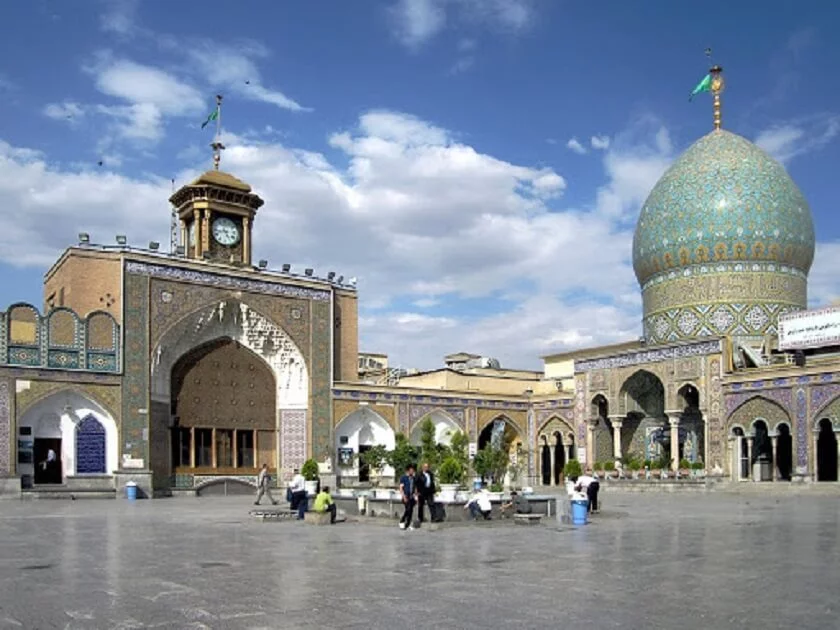
The architecture of the shrine is a mix of history and craftsmanship, built and renovated through centuries by the Buyid, Seljuk, Safavid, and Qajar dynasties. With a unique geometric design that rises from square to dome, and stunning interiors filled with mirrorwork, tilework, and wood carvings, the shrine is a visual treat. You’ll also find a museum with ancient artifacts—from 12th-century doors and decorative locks to rare coins, manuscripts, and religious paintings. Don’t miss the Jeyran Garden, built by Naser al-Din Shah in memory of his beloved wife, or the Tooti Garden cemetery, where famous Iranian figures are buried, offering a deeper look into the country’s cultural and political past.
Beyond the main shrine, the complex has much more to explore. Courtyards, beautifully tiled corridors, a silver shrine enclosure, and historic wooden chests all tell stories from different eras. You’ll also find the Abdol Azim Bazaar, a traditional market dating back to the Safavid era, where you can shop for spices, clothes, and local food. Access is easy—there’s a large parking area and a nearby metro station, though during busy religious events, arriving early is smart. Whether you’re a pilgrim, a history lover, or a cultural traveler, Shah Abdol Azim Shrine offers a rich, peaceful, and unforgettable experience in South Tehran.
Shah Cheragh Shrine in Shiraz
The Shah Cheragh Shrine, located in the historic city of Shiraz, is one of the most significant religious destinations in Iran. This sacred site is the burial place of Seyyed Amir Ahmad (Shah Cheragh), the eldest son of Imam Musa Kazim and brother of Imam Ali Reza. Recognized as a national heritage site since 1321 (1922), the shrine holds deep religious and cultural value for Iranians. The architecture of the shrine blends Islamic and Iranian artistic traditions, with stunning mirror work and tile mosaics creating a serene and spiritual atmosphere. The shrine is built in the Azerbaijani style, a prominent architectural style from the Ilkhanid period. Inside the shrine, visitors can admire intricate Persian and Arabic calligraphy surrounding the beautiful mirrors and tiles.
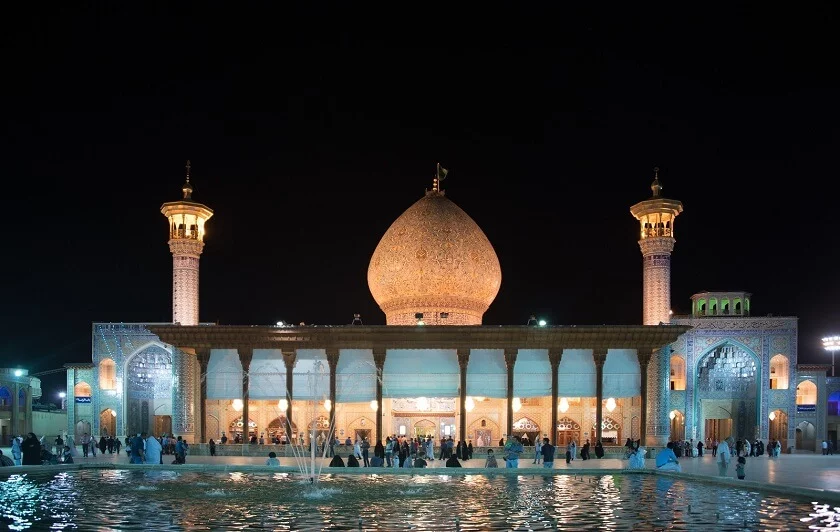
The history of the Shah Cheragh Shrine dates back to the time of the Buyid dynasty, around the 10th century. Initially, the site where the shrine is located was a simple mound of earth, but it became a place of reverence after a series of remarkable events. According to local legend, a woman in Shiraz observed a light shining over the mound on several Friday nights. This led her to believe that it was the burial site of a revered figure. Her discovery prompted the Buyid ruler, Amir Adhd al-Dawla, to investigate the site, ultimately confirming that it was the resting place of Seyyed Amir Ahmad. Over the centuries, the shrine underwent several renovations, particularly during the reign of various rulers such as the Safavids and Qajars, who enhanced the site’s architecture and facilities.
Located in the heart of Shiraz on Lutfali Khan Zand Street, the Shah Cheragh Shrine is easily accessible for tourists. The shrine features four courtyards named after different Imams, including Imam Jawad, Hazrat Masoumeh, the main courtyard, and the Atiq Courtyard. The shrine also houses three prayer halls, including Dar al-Abadah, Hazrat Sayyed Mir Mohammad, and the Imam Khomeini Prayer Hall. The shrine’s layout includes a beautiful fountain in the central courtyard surrounded by lush trees, and the sacred tomb of Seyyed Amir Ahmad is placed beneath a magnificent silver-covered shrine. With its historical significance, beautiful architecture, and spiritual atmosphere, visiting Shah Cheragh offers an enriching experience for both religious pilgrims and cultural tourists alike.
Want to make the most of your Shiraz visit? Check out the Comprehensive Guide to Must-Visit Attractions in Shiraz now.
Imamzadeh Saleh Shrine in Tehran
Imamzadeh Saleh is a significant religious site located in the vibrant district of Tajrish, Tehran. He is the son of Imam Musa Kazim and the brother of Imam Reza (a.s.), both prominent figures in Shia Islam. According to historical accounts and Shia traditions, Imamzadeh Saleh traveled from Iraq to Iran after being appointed as a successor to Imam Reza. However, during his journey, he was martyred in Tajrish, near the Golsahan Garden, under a large chinar tree. His burial site has become a cherished place for Iranians, attracting thousands of visitors every year. The shrine, with its peaceful and spiritual atmosphere, offers a place for prayer and reflection, with a strong historical and religious significance.
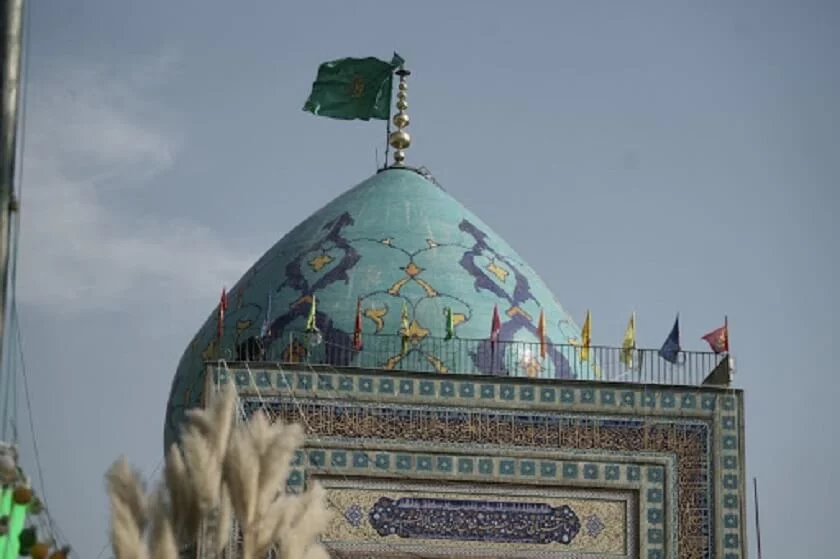
Imamzadeh Saleh in Tehran’s Tajrish neighborhood is one of the most revered religious sites in the city. It is the shrine of Saleh ibn Musa al-Kadhim, the brother of Imam Reza, who died as a martyr while traveling from Iraq to Iran. His body was laid to rest in Tajrish, where the shrine now stands as a center of spiritual significance. This sacred place is visited by thousands of pilgrims and visitors annually, making it an essential stop on any trip to Tehran.
The Imamzadeh Saleh complex is easily accessible from various parts of Tehran. It is located on Imamzadeh Street in Tajrish and is surrounded by a beautiful and peaceful environment. Visitors can enjoy the unique architecture and the tranquil atmosphere. One of the most notable rituals associated with this site is the Salt Vow, where pilgrims used to bring salt to melt the heavy snow during winter, making it easier to walk. This practice has evolved into a tradition that continues today, symbolizing hope and blessings.
Nearby, there are several must-see attractions that make visiting the area even more special. Tajrish Bazaar, with its historic charm, is a popular spot for shopping and exploring traditional goods. Saadabad Palace, located only a short distance away, is a beautiful and historic site worth visiting, offering insights into Iran’s royal history. You can also enjoy the scenic beauty of the Vali Asr Street and visit the Garden Museum of Cinema at Bagh Ferdows. These locations are perfect additions to your visit, allowing you to experience both the spiritual and cultural richness of Tehran.
Imam Khomeini Shrine in Tehran
The Imam Khomeini Shrine, located in the southern part of Tehran, is one of the most significant religious sites in Iran. It is the burial place of Imam Khomeini, the founder of the Islamic Republic, and attracts large numbers of visitors, especially during significant events like his anniversary. The shrine complex, with its magnificent architecture, not only serves as a religious site but has become a popular destination for tourists as well. The shrine is located near Behesht Zahra, Tehran’s main cemetery, and is easily accessible from various parts of the city. It is well-connected by road, with several parking lots available for visitors. Additionally, a metro station located nearby ensures easy access for those without a car.
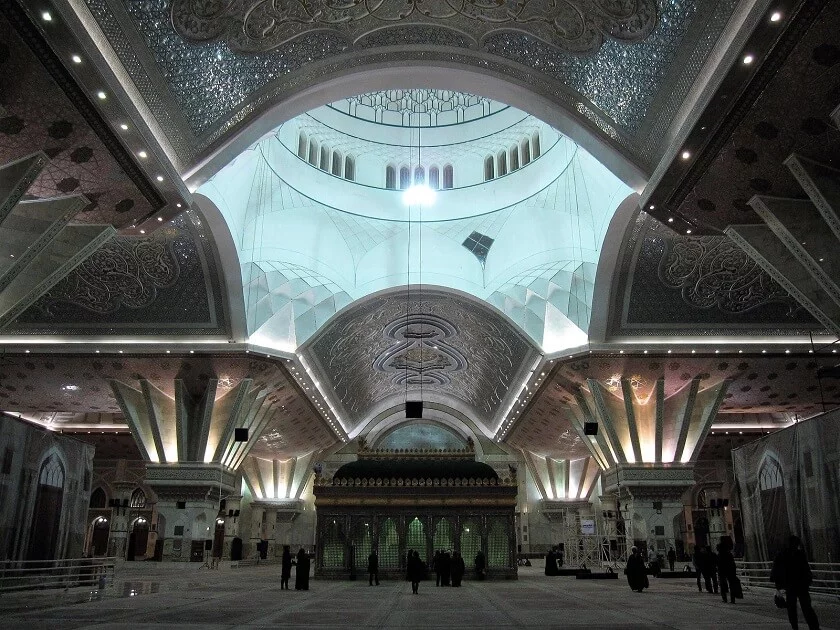
The construction of the Imam Khomeini Shrine began in 1989, just a year after the death of Imam Khomeini. The architecture of the shrine is a beautiful blend of modern and traditional Islamic styles. Designed by renowned architect Parviz Moyed-Ahd, the shrine features impressive elements such as five large domes symbolizing the five holy figures of Shia Islam. The central dome, made of metal, is supported by eight massive pillars, and the entire structure is designed to withstand even a major earthquake. The shrine spans a large area, and its interior is adorned with Islamic motifs, mirrors, and intricate tile work, all contributing to its awe-inspiring beauty.
Today, the Imam Khomeini Shrine is not only a place for religious ceremonies and pilgrimages but also a center for cultural and social activities. The complex includes hotels, shopping centers, restaurants, and even a theme park, making it a destination for both spiritual and recreational visits. Visitors can find places to stay, such as the nearby Aftab Hotel, which offers comfortable accommodation, along with several other facilities designed for the comfort of visitors. The shrine is also close to other significant locations like the Shahr-e Aftab Exhibition Center. For those planning to visit, the shrine provides a range of services to ensure a smooth and enjoyable experience.
Make the most of your Tehran visit—read the Comprehensive Guide to Must-Visit Attractions in Tehran for insider tips.
How to Perform Ziyarat
Ziyarat involves pilgrimage to the holy shrines of Prophet Muhammad and his descendants. During this pilgrimage, customs and traditions are observed out of respect for the sacred bodies. These rituals include reciting Ziyarat prayers, Dua, and the Quran. Photography isn’t permitted at these shrines; instead, visitors admire the grandeur to feel closer to God.
Ziyarat culture embodies a profound spiritual journey steeped in tradition and reverence. Pilgrims from all corners of the globe flock to the Imam Reza Shrine, where the rituals of Ziyarat unfold in a deeply spiritual atmosphere. Before entering the shrine, it is customary for pilgrims to perform Ghusl, a ritual purification bathing, symbolizing a cleansing of the soul before approaching the holy site. With hearts filled with devotion, pilgrims offer prayers and supplications, seeking blessings and guidance from Imam Reza.
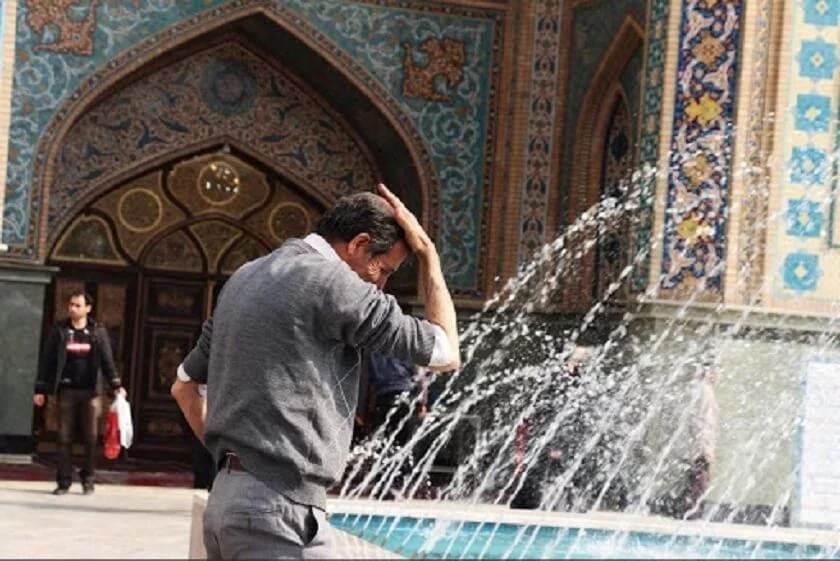
Dua is an integral aspect of the pilgrim experience in Mashhad, as it provides a direct channel for communication with the divine. Pilgrims approach the shrine with reverence and humility, their hearts filled with devotion as they recite prayers in various languages, beseeching Allah for forgiveness, guidance, and fulfillment of their wishes and needs. Whether whispered in quiet reverence or recited aloud amidst the bustling crowds, these prayers carry the hopes, dreams, and aspirations of pilgrims who have traveled far and wide to seek solace and spiritual enlightenment.
As part of the Ziyarat culture, wearing a chador, a traditional garment, is considered essential for women. The chador symbolizes humility and modesty, allowing pilgrims to immerse themselves fully in the spiritual experience. Wrapped in the comforting embrace of their chadors, pilgrims experience a journey of introspection and prayer, connecting with the divine presence that permeates the sacred space of the shrine.
For more information, you can read our article on Iran Pilgrimage Guide: Etiquettes of Ziyarat. And don’t miss our Iran Ziyarat Visa Comprehensive Guide; everything you need to know about the visa process, requirements, and how to get started smoothly.
Experience the ease of planning your Ziyarat journey with Visit Our Iran. Submit your Ziyarat visa request through our convenient Visa Form or simply reach out to us via the WhatsApp icon at the bottom right corner of the page.
Explore Ziyarat Journey in Iran with Us
Immersing yourself in Iran’s Ziyarat journey offers a deeply enriching spiritual experience filled with reverence, reflection, and cultural immersion. From the majestic shrines of Mashhad to the serene sanctuaries of Qom and beyond, each destination holds its own significance and beauty. At every step of the way, visitors are welcomed with open arms, supported by our dedicated team who are ready to assist with visa arrangements and guided tours. Whether seeking solace, seeking blessings, or simply exploring the rich heritage of Islam, Iran’s Ziyarat promises an unforgettable experience. Contact us today; we’re here to support and accompany you on your sacred journey.
